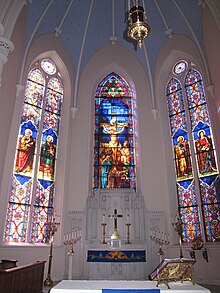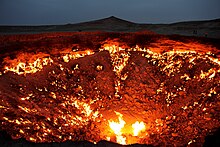Eternal flame
In ancient times, eternal flames were fueled by wood or olive oil;[citation needed] modern examples usually use a piped supply of propane or natural gas.
Human-created eternal flames most often commemorate a person or event of national significance, serve as a symbol of an enduring nature such as a religious belief, or a reminder of commitment to a common goal, such as diplomacy.
[1] The eternal flame was a component of the Jewish religious rituals performed in the Tabernacle and later in the Temple in Jerusalem, where a commandment required a fire to burn continuously upon the Outer Altar.
[citation needed] In traditional Christian denominations, such as Catholicism and Lutheranism, a chancel lamp continuously burns as an indication of the real presence of Christ in the Eucharist.
[4] In China, it has at times been common to establish an eternally lit lamp as a visible aspect of ancestor veneration; it is set in front of a spirit tablet on the family's ancestral altar.






















